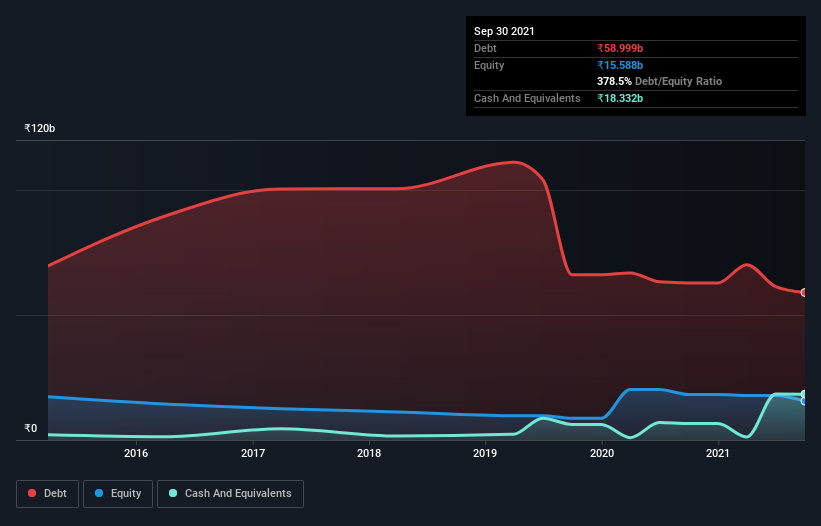
Some say volatility, rather than debt, is the best way to think about risk as an investor, but Warren Buffett famously said that 'Volatility is far from synonymous with risk.' So it seems the smart money knows that debt - which is usually involved in bankruptcies - is a very important factor, when you assess how risky a company is. We can see that Sadbhav Engineering Limited (NSE:SADBHAV) does use debt in its business. But the more important question is: how much risk is that debt creating?
What Risk Does Debt Bring?
Debt is a tool to help businesses grow, but if a business is incapable of paying off its lenders, then it exists at their mercy. Part and parcel of capitalism is the process of 'creative destruction' where failed businesses are mercilessly liquidated by their bankers. While that is not too common, we often do see indebted companies permanently diluting shareholders because lenders force them to raise capital at a distressed price. Of course, plenty of companies use debt to fund growth, without any negative consequences. When we think about a company's use of debt, we first look at cash and debt together.
Check out our latest analysis for Sadbhav Engineering
What Is Sadbhav Engineering's Debt?
The image below, which you can click on for greater detail, shows that Sadbhav Engineering had debt of ₹59.0b at the end of September 2021, a reduction from ₹62.8b over a year. On the flip side, it has ₹18.3b in cash leading to net debt of about ₹40.7b.

A Look At Sadbhav Engineering's Liabilities
According to the last reported balance sheet, Sadbhav Engineering had liabilities of ₹45.1b due within 12 months, and liabilities of ₹61.5b due beyond 12 months. Offsetting this, it had ₹18.3b in cash and ₹5.67b in receivables that were due within 12 months. So it has liabilities totalling ₹82.6b more than its cash and near-term receivables, combined.
This deficit casts a shadow over the ₹7.52b company, like a colossus towering over mere mortals. So we definitely think shareholders need to watch this one closely. After all, Sadbhav Engineering would likely require a major re-capitalisation if it had to pay its creditors today.
In order to size up a company's debt relative to its earnings, we calculate its net debt divided by its earnings before interest, tax, depreciation, and amortization (EBITDA) and its earnings before interest and tax (EBIT) divided by its interest expense (its interest cover). Thus we consider debt relative to earnings both with and without depreciation and amortization expenses.
Weak interest cover of 0.66 times and a disturbingly high net debt to EBITDA ratio of 7.7 hit our confidence in Sadbhav Engineering like a one-two punch to the gut. This means we'd consider it to have a heavy debt load. Investors should also be troubled by the fact that Sadbhav Engineering saw its EBIT drop by 15% over the last twelve months. If that's the way things keep going handling the debt load will be like delivering hot coffees on a pogo stick. When analysing debt levels, the balance sheet is the obvious place to start. But it is Sadbhav Engineering's earnings that will influence how the balance sheet holds up in the future. So when considering debt, it's definitely worth looking at the earnings trend. Click here for an interactive snapshot.
Finally, a company can only pay off debt with cold hard cash, not accounting profits. So the logical step is to look at the proportion of that EBIT that is matched by actual free cash flow. Over the last three years, Sadbhav Engineering actually produced more free cash flow than EBIT. There's nothing better than incoming cash when it comes to staying in your lenders' good graces.
Our View
On the face of it, Sadbhav Engineering's interest cover left us tentative about the stock, and its level of total liabilities was no more enticing than the one empty restaurant on the busiest night of the year. But at least it's pretty decent at converting EBIT to free cash flow; that's encouraging. Overall, it seems to us that Sadbhav Engineering's balance sheet is really quite a risk to the business. So we're almost as wary of this stock as a hungry kitten is about falling into its owner's fish pond: once bitten, twice shy, as they say. When analysing debt levels, the balance sheet is the obvious place to start. However, not all investment risk resides within the balance sheet - far from it. For example Sadbhav Engineering has 2 warning signs (and 1 which is potentially serious) we think you should know about.
If, after all that, you're more interested in a fast growing company with a rock-solid balance sheet, then check out our list of net cash growth stocks without delay.
New: Manage All Your Stock Portfolios in One Place
We've created the ultimate portfolio companion for stock investors, and it's free.
• Connect an unlimited number of Portfolios and see your total in one currency
• Be alerted to new Warning Signs or Risks via email or mobile
• Track the Fair Value of your stocks
This article by Simply Wall St is general in nature. We provide commentary based on historical data and analyst forecasts only using an unbiased methodology and our articles are not intended to be financial advice. It does not constitute a recommendation to buy or sell any stock, and does not take account of your objectives, or your financial situation. We aim to bring you long-term focused analysis driven by fundamental data. Note that our analysis may not factor in the latest price-sensitive company announcements or qualitative material. Simply Wall St has no position in any stocks mentioned.
Have feedback on this article? Concerned about the content? Get in touch with us directly. Alternatively, email editorial-team (at) simplywallst.com.
About NSEI:SADBHAV
Sadbhav Engineering
Engages in engineering, construction, and infrastructure development projects business in India.
Good value low.
Similar Companies
Market Insights
Community Narratives



